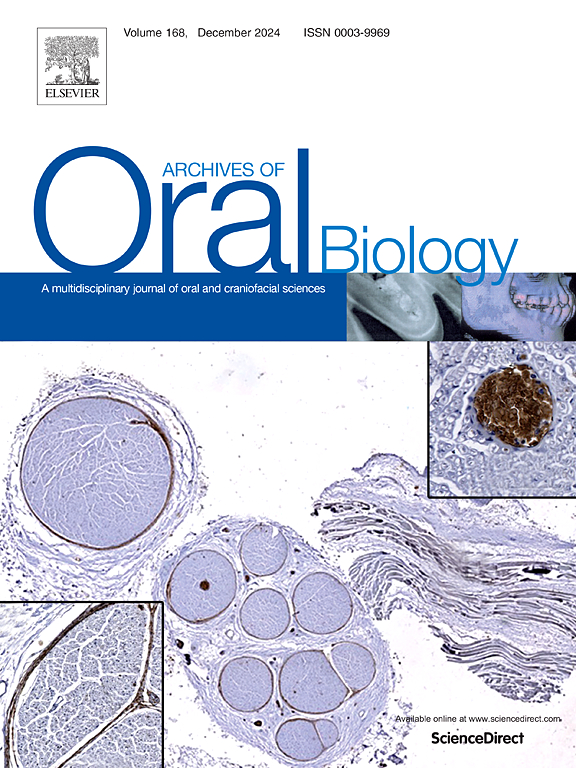巴基斯坦拉合尔地区恒上颌磨牙牙尖形态特征及龋易感性的研究
IF 2.1
4区 医学
Q2 DENTISTRY, ORAL SURGERY & MEDICINE
引用次数: 0
摘要
目的了解巴基斯坦拉合尔地区上颌恒磨牙Carabelli尖(CoC)的患病率、形态特征及龋易感性。设计在拉合尔医学和牙科学院对432名12岁或以上的参与者进行了一项描述性横断面研究。采用亚利桑那州立大学口腔人类学系统(ASUDAS)对上颌第一、第二磨牙进行CoC特征的临床检查,采用国际龋齿检测与评估系统(ICDAS)对龋齿进行评估。审查员之间和内部的校准确保了诊断的可靠性(Cohen's Kappa >0.90)。结果上颌第一磨牙有201例(46.5 %)、第二磨牙有7例(1.6 %)出现scoc (ASUDAS分级1 ~ 7级),双侧表达较单侧多见。右第一磨牙CoC患病率和龋发病率较高。形态特征从细微的凹槽到明显的尖头,以小的垂直凹槽(ASUDAS 1)最为常见。龋易感性与CoC显著性呈正相关(p <; 0.001)。多变量logistic回归发现CoC分级是龋病、遮蔽年龄、侧边和磨牙位置的最强预测因子,并显著提高了模型敏感性(0 %至97.2% %)。结论coc是上颌第一磨牙早期龋病的普遍特征,与早期龋病有显著关系。它的存在,特别是突出的形式,可能会增加患龋的风险。这些发现强调需要加强对CoC患者的预防策略和临床关注。本文章由计算机程序翻译,如有差异,请以英文原文为准。
Morphological traits and caries susceptibility of the cusp of carabelli in permanent maxillary molars: A study in Lahore, Pakistan
Objective
To evaluate the prevalence, morphological traits, and caries susceptibility of the Cusp of Carabelli (CoC) in permanent maxillary molars among patients in Lahore, Pakistan.
Design
A descriptive cross-sectional study was conducted among 432 participants aged 12 years or older at Lahore Medical and Dental College. Clinical examination of maxillary first and second molars was performed using the Arizona State University Dental Anthropology System (ASUDAS) for CoC traits and the International Caries Detection and Assessment System (ICDAS) for caries assessment. Inter- and intra-examiner calibration ensured diagnostic reliability (Cohen's Kappa >0.90).
Results
CoC (ASUDAS grades 1–7) was observed in 201 individuals (46.5 %) on maxillary first molars and in 7 individuals (1.6 %) on second molars, with bilateral expression more common than unilateral. The right first molar showed a higher prevalence of CoC and caries incidence. Morphological traits ranged from subtle grooves to pronounced cusps, with small vertical grooves (ASUDAS 1) being the most frequent. Caries susceptibility correlated positively with CoC prominence (p < 0.001). Multivariate logistic regression identified CoC grade as the strongest predictor of caries, overshadowing age, side, and molar position, and substantially improving model sensitivity (0 % to 97.2 %).
Conclusion
CoC is a prevalent trait and is significantly associated with early-stage dental caries in maxillary first molars. Its presence, particularly in prominent forms, may pose an increased risk of caries. These findings underscore the need for enhanced preventive strategies and clinical attention in individuals with CoC.
求助全文
通过发布文献求助,成功后即可免费获取论文全文。
去求助
来源期刊

Archives of oral biology
医学-牙科与口腔外科
CiteScore
5.10
自引率
3.30%
发文量
177
审稿时长
26 days
期刊介绍:
Archives of Oral Biology is an international journal which aims to publish papers of the highest scientific quality in the oral and craniofacial sciences. The journal is particularly interested in research which advances knowledge in the mechanisms of craniofacial development and disease, including:
Cell and molecular biology
Molecular genetics
Immunology
Pathogenesis
Cellular microbiology
Embryology
Syndromology
Forensic dentistry
 求助内容:
求助内容: 应助结果提醒方式:
应助结果提醒方式:


